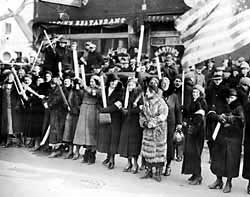Little-known
Strategic roles of Black workers, women in Flint sit-down strike
By
Martha Grevatt
Published Mar 10, 2007 10:23 PM
1937 FLINT SIT-DOWN LABOR HISTORY SERIES
PARTS: 1 2 3 4 5 6 7 8 9 10
The 70th anniversary of the Flint, Mich., sit-down strike, celebrated Feb. 11,
is an occasion to celebrate not only the struggle’s well-known aspects
but some of the lesser-known.
Over 300 women sat down initially, but the male United Auto Workers’
leadership did not allow them to stay inside the plants. Nevertheless, women
were absolutely indispensable.
In their traditional role they kept the men alive, cooking for the hundreds and
sometimes thousands of their co-workers and loved ones inside the plants. They
set up first-aid stations, and child care for women picketers.
Pat Wiseman, who initially sat down with the men, refused to cook. Instead she
became a picket leader outside. She never missed a day. She later helped
negotiate the first UAW contract with General Motors.
Genora Johnson organized the Women’s Emergency Brigade, which proved
pivotal when police attacked. The New York Times reported that strikers had a
“large supply of blackjacks ... whittled down so that they can be swung
or jabbed readily.” In fact the clubs had been whittled down by the
Women’s Brigade to fit their smaller hands.
When tear gas was fired into the plants, women smashed the windows to allow the
gas to escape.
Norman Bully, who would procure food donations from supportive farmers and
deliver it to the kitchens, remarked years later: “God, all the women.
The Women’s Brigade was something.” The Women’s Emergency
Brigade was rescued from obscurity by the 1979 documentary “With Babies
and Banners.”
All of GM’s Flint operations were strictly Jim Crow. Only a few hundred
Black workers were employed in all the plants combined. They were segregated,
and only allowed to use certain exits.
Many Black workers, including Communists like J. D. Dotson, picketed outside
the struck plants. They not only stood up to the cops, the National Guard,
vigilantes, and the “Black Legion”—a Northern version of the
Ku Klux Klan—but they took on their employer when jobs for
African-Americans were particularly scarce. They also had to deal with the
backwardness of some of the white picketers.
Roscoe Van Zandt, who sat down at Chevrolet 4, is the only Black worker known
to have participated inside. The first night he stayed to himself, but by the
next day, because he was older, the workers had voted that he should take the
only bed in the plant.
When they marched out on Feb. 11, still patriotic to the government that had
fired on them, it was Van Zandt who was chosen to carry the U.S. flag.
Van Zandt later spoke to Black churches about the strike and the UAW. It is
unfortunate that, despite a number of books and films about the sit-down,
relatively little information about the particular bravery of workers like Van
Zandt and Dotson has been preserved for future generations.
Go to www.workers.org for the first installment. There will be more to come
about this historic event.
1937 FLINT SIT-DOWN LABOR HISTORY SERIES
PARTS: 1 2 3 4 5 6 7 8 9 10
Articles copyright 1995-2012 Workers World.
Verbatim copying and distribution of this entire article is permitted in any medium without royalty provided this notice is preserved.
Workers World, 55 W. 17 St., NY, NY 10011
Email:
[email protected]
Subscribe
[email protected]
Support independent news
DONATE


